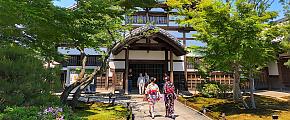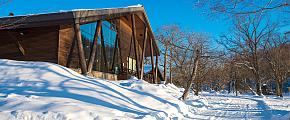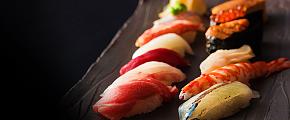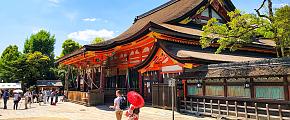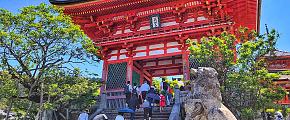Tokyo Travel Guide
Tokyo is the capital of Japan and one of the largest cities in the world. For many. Tokyo is a vibrant and modern city. It is always at the forefront of fashion. Your knowledge of Tokyo may have come from Hayao Miyazaki's animations or the films directed by Akira Kurosawa. The street fashion of Harajuku is also widely spread, and sushi and tavern Japanese shochu is loved by most people around the world. Tokyo is a must-visit destination during your trip to Japan. Do you want to visit Tokyo? Next, let's go into Tokyo and get to know Tokyo.
Famous Tourist Attractions in Tokyo
1. Tokyo Disneyland
Tokyo Disneyland, built in 1982, was a collaboration between the U.S. Disney Company and Nihon Zai Design. It is known as the first amusement park in Asia and was built according to the American Disneyland. Tokyo Disneyland is mainly divided into seven zones: World Market, Adventureland, Western Paradise, Animal World, Fantasyland, Toon Town and Tomorrowland. The domestic stages and plazas hold various parades at regular intervals. Tokyo Disney retains the authentic style of American Disney, allowing one to deeply appreciate the characteristics of its shows. It is suitable for people of all ages.
Address: Maihama, Urayasu City, Chiba Prefecture, east of Tokyo, Japan
Opening hours: Monday to Friday 9:00-22:00
Saturday to Sunday 8:00-22:00
 Tokyo Disneyland
Tokyo Disneyland
2. Akihabara
Akihabara is a tourist attraction located in the center of Tokyo. It has both sides of light and shadow at the same time. For some, it means the world's largest electrical street. Most of the stores in the Akihabara area sell home appliances, computers and related peripheral products. It is known as the "electrical street that keeps pace with the cutting-edge industries of the times. For hundreds of millions of otaku around the world, these three words have incomparable magic. It is also the birthplace of Japanese anime culture, with anime, manga, video games, and doll stores everywhere, as well as many idol stores, anime cafes, and maid cafes, where you can often see young boys and girls cosplaying, making it a major "mecca" for otaku and anime fans. You will see maids dressed up as girls walking through the streets here. It is also the home of AKB48, the number-one girl idol group in the Japanese music industry, and there is a special AKB48 theater on the 8th floor of the Don Quijote store, where they perform almost every day. Whether you are obsessed with anime or not, if you have the chance to come to Tokyo, please go to Akihabara.
Address: Akihabara, Chiyoda-ku, Tokyo
Opening hours: All day
 Akihabara
Akihabara
3. Asakusa Temple
Asakusa Temple is one of Japan's remaining "Edo-style" places of popular entertainment. Asakusa is the birthplace of Tokyo. Asakusa Temple is the oldest temple in Tokyo. Also known as Asakusa Ramen Kannon Temple, the temple's official name is Kinryuzan Asakusa Temple. According to the legend, in 628 A.D., a pair of brothers who made their living by fishing found a Kannon statue in the Sumida River and thought it was a "Kannon apparition". As a result, a temple was built in the area and dedicated to Kannon. The symbol of Asakusa Temple is the Wind and Thunder God Gate at the entrance, with the Wind God and the Thunder God guarding the temple on the left and right respectively, and a huge red lantern with the word "Thunder Gate" written on the gate, which is 3.4 meters in diameter, 4 meters high and weighs 67 kilograms. After passing through the large red lantern of the Thunder Gate, you will find Nakamise Shopping Street, which is filled with more than 100 Japanese specialty stores on a road of about 300 meters. There are local products such as Tokyo's famous Ray Rice flower candy, pancakes, balls, Edo toys, kimonos, unibeki, and more. This is one of the liveliest shopping streets in Tokyo, so any time you go, you will see it packed with people. When you come to the main Asakusa temple you will see the treasure gate, and from here you will enter the main hall, where there is a huge incense burner in the square and many people will fan the smoke on themselves to shelter their health. To the southwest of the main hall is the five-story pagoda, the uppermost level of which contains the relics of Shakyamuni Buddha. It costs only 100 yen or about 0.7 USD to ask for a lottery ticket at Asakusa Temple. You can wash your hands at the statue of the Dragon King in front of the main hall, then go to the place where you ask for the sign, shake the stick, and then go to the corresponding drawer to find the text according to the number on the stick. The text is a Chinese poem with explanations in Japanese and English. If you are not satisfied with the sign, you can tie it to the tree next to you in order to turn bad luck into good luck.
Address: Taito-ku, Tokyo
Opening hours: April to September 6:00-17:00
October to March 6:30-17:00
 Asakusa Temple
Asakusa Temple
4. Tokyo Skytree
Tokyo Skytree, also known as the New Tokyo Tower .and before its official name, New Tokyo Tower and Sumida Tower, is a radio tower located in Sumida-ku, Tokyo, Japan. With a height of 634 meters, the tower was certified as the world's tallest tower by Guinness World Records on November 17, 2011, making it the tallest self-supporting tower in the world. It is currently the second tallest man-made structure in the world, after the Burj Khalifa in Dubai. The four elevators that go from the ground to the Skywatch Deck of the TOKYO SKYTREE are designed with different background themes according to spring, summer, autumn and winter. The elevators run at a speed of about 600m per minute and take about 50 seconds to ride. Each ride is different and refreshing.
Spring (elevator 3) Cherry blossom sky of Sakura-buki snow
Summer (elevator 4) Fireworks in the sky of the Sumida River
Autumn (elevator 5) Phoenix shining in the sky of the festival
Winter (elevator 6) A bird's eye view of the snow-capped Mt.
Address: Mukaijima, Sumida-ku, Tokyo
Opening hours: 10:00-21:00 everyday
5. Meiji Shrine
There is the largest wooden torii in Japan in the north and south sento of Meiji Jingu Shrine. As you walk along the sento, there is a row of sake barrels on each side at the end of the south sento: the left column is a western wine barrel and the right column is a Japanese sake barrel. As you continue to walk ahead, you will reach the South Shinto Gate of the main hall. At this time, you need to meditate and first wash your left hand with the ladle in your right hand, then wash your right hand with the ladle in your left hand, and then switch to the ladle in your right hand to scoop a ladle of water into your left hand and hold it in your mouth as a sign of respect to the gods. People can also have a wedding here, but of course it must be a Japanese wedding.
Address: Yoyogi, Shibuya-ku, Tokyo
Opening hours: varies from month to month, roughly 6:40 - 16:00, please refer to the Meiji Jingu website for exact hours.
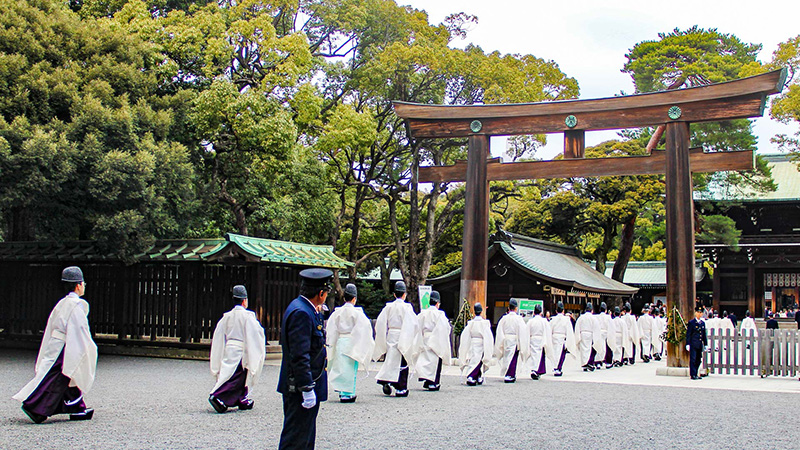 Meiji Shrine
Meiji Shrine
6. Ginza
Ginza is one of the most representative shopping districts in Japan, and is one of the top three shopping districts in the world, along with the Champs Elysees in Paris and Fifth Avenue in New York. It is one of the top three shopping districts in the world. Ginza, which stretches from 1-chome to 8-chome, is the most luxurious business district in Tokyo and is known as "the most expensive place in Asia". It is home to more than 1,000 bars, cabarets and nightclubs of various sizes and levels. Some of the most famous ones include the Wako Store, Mitsukoshi Department Store, Sanae Building, and Tokyo Hatsujido, making it a must-see stop on any visit to Tokyo. In these department stores, you can not only shop for trendy items from all over the world, but also experience the historical and traditional Japanese culture and attentive and warm professional services.
Address: West of Chuo-ku, Tokyo
Opening hours: Open all day, all year round
7. Ueno Park
Ueno Park is one of the five oldest parks in Japan. It is famous for its Ueno Zoo, its many museums, and the cherry blossoms that bloom in spring. Ueno Park was opened to the public in 1873 under the official name of Ueno Entsu Park. The park is home to many famous monuments, museums, the National Museum of Western Art, the Tokyo Metropolitan Museum of Art, and the Ueno Zoological Garden. The old trees, high platforms, temples, dark pavilions, bright paper lanterns, and bright fountains in the park are a blend of Edo and Tokyo, showing a variety of styles from ancient and modern Japan. In addition, a grand "Cherry Blossom Festival" is held here every year during the cherry blossom season.
Address: Taito-ku, Tokyo, Japan
Opening hours: 5:00-23:00 all year round
Popular Events in Tokyo
1. Tokyo Fireworks Festival
Fireworks are the most beautiful thing in Japan in summer. Every year, on the weekend of July and August, Japan holds a fireworks display. At that time, there are many people who wear yukata to the fireworks display, and of course, there are also many people who wear everyday clothes. Yukata in this case refers to a kind of kimono. If you want to participate in a fireworks display, you need to go to the official website of the fireworks display, which will provide the most comprehensive and specific information. Find the one you want to attend and you will see a map of the venue and transportation information. Many fireworks display will offer paid seats, which need to be reserved and purchased in advance. Fireworks conventions are crowded, so remember to get out early!
2. Ueno Cherry Blossom Festival
Every year, from March 15 to April 15, Ueno celebrates the annual "Sakura Matsuri" (Cherry Blossom Festival). There are over 1,000 cherry trees in Ueno Park in Tokyo, and from the end of March to the beginning of April, they are transformed into a sea of pink cherry blossoms, which is especially beautiful. Many people like to come here for picnics with their families and friends, they enjoy the flowers and chat while enjoying them, and at night the garden is lit up with night lights that shine on the cherry blossoms, it's super pretty! There is no admission fee to Ueno Park, so if you want to come to Tokyo to see the cherry blossoms, you just need to come at the right time.
3. Marunouchi Illuminations
The 1.2km-long Nakadori Street in Marunouchi is decorated with about one million colored lights, which are turned on collectively at night to illuminate the street. It is called the "Marunouchi Illumination" and attracts many visitors every year. This light show starts in mid-November and ends in mid-February each year. If you want to see the magical sight of millions of lights lit up together, don't miss this event.
Travel Tips
1. Every year, once spring is over, there are intermittent rain showers for two or three days and up to a week between May and July. If you come during this period, please remember to prepare an umbrella.
2. If you want to see cherry blossoms. Please come to Tokyo in late March and early April
3. If you want to see the fireworks display, please come in July and August every year.
4. If you want to see the illumination exhibition, please come every year from November to February.
Tokyo has four distinct seasons. Spring is mild and summer is hot and humid with typhoons. Autumn is cool and pleasant, and winter is cold. Snow is infrequent, but the early months of the year usually see snowfall. Please choose the tour time appropriately according to your preference.
If you're planning to travel to Japan and explore charming Tokyo, please don't hesitate to contact us, and one of our travel experts will create a tailor-made itinerary based on your interests and needs within 24hrs.


